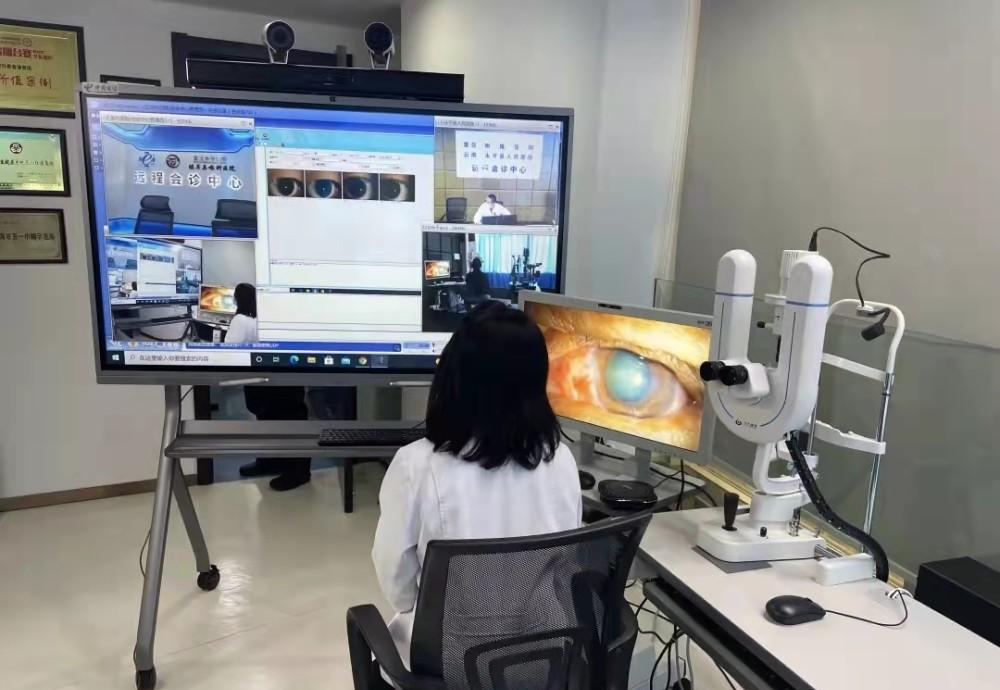Doctors in Shanghai can "win thousands of miles" to diagnose eye diseases for patients in Yunnan. Newborns with difficult and critical illnesses have just been sent to an ambulance, waiting for experts in the hospital to have "strategized" to judge the condition. Medical workers everywhere can share scientific research results and typical cases in real time...
Shanghai recently focused on displaying a number of application cases that won awards in the fourth "Bloom Cup" 5G application competition. In recent years, a number of hospitals in Shanghai, together with communication operators, have introduced technologies such as 5G, edge computing, blockchain, and artificial intelligence (AI) in the process of remote diagnosis and treatment and emergency treatment, so as to promote the sharing of medical resources in more regions and in a wider range of scenarios.
"How long has the redness and swelling lasted when the eyes moved?" A doctor at the Eye, Ear, Nose and Throat Hospital affiliated to Fudan University in Shanghai "looks, smells and cuts" at the computer screen, and the high-definition 3D screen presents the patient's symptoms. Compared with the past remote consultation, doctors can only refer to medical history data, and the real-time picture allows doctors to more accurately prescribe the right medicine. At the other end of the screen, a patient who is visiting a hospital in Yunnan, more than 2,000 kilometers from Shanghai, does not have to spend time and money on long-distance transportation to get the timely service of Shanghai doctors.

Doctors from the Eye, Ear, Nose and Throat Hospital affiliated to Fudan University conduct real-time remote diagnosis and treatment of patients in Yunnan. (Courtesy of the interviewee)
According to the staff of Shanghai Telecom, who participated in the construction of the "naked-eye 3D slit lamp 5G remote diagnosis and treatment platform", the 5G network has the characteristics of low latency and large bandwidth, and can quickly transmit videos, pictures and other information that are crucial to the diagnosis and treatment process. It is understood that the "remote diagnosis of eye, ear, nose and throat diseases based on 5G + AI" project has been piloted in the Yangtze River Delta (Shanghai) Smart Internet Hospital and the Yongping County People's Hospital in Yunnan Province to meet the medical needs of the people.
"Smart medical care based on 5G technology can not only enable hospitals to continue to grow, but also benefit more people, so that people living in different regions can enjoy homogeneous medical services." Zhou Xingtao, president of the Affiliated Eye, Ear, Nose and Throat Hospital of Fudan University, said.
Huashan Hospital affiliated to Fudan University and Shanghai Unicom jointly built the "Ultra-portable Mixed Reality Cranial Surgery Navigation System under 5G Architecture", which builds an augmented reality visualization surgical navigation platform based on the 5G medical private network and medical cloud platform, which can help doctors to more accurately segment, reconstruct and assist the positioning of patients' brain tissue and lesions. Doctors in Shanghai can analyze remote images from primary hospitals in remote areas and give local doctors the necessary remote real-time guidance before and during surgery.
The rapid development of communication infrastructure such as "double gigabit" networks represented by gigabit optical networks and 5G plays an important role in strengthening talent training in various places. According to Shanghai cadres aiding Tibet, many Shanghai doctors consulted online during the epidemic and taught Shigatse doctors and shared the latest scientific research results and typical cases.
According to data from the Ministry of Industry and Information Technology, the mainland has built and opened 1.425 million 5G base stations, and 512,000 administrative villages across the country have fully realized "village broadband". Whether living in a bustling city or a quiet village, more and more people are enjoying the dividends brought by the digital wave.
Hospitals and operators in Shanghai have also strengthened cooperation to promote the continuous enrichment of "5G+" application scenarios in the city.
A "smart referral cabin" for newborn referral. Photo by Xinhua News Agency reporter Chen Aiping
The Children's Hospital of Fudan University, together with Shanghai Telecom's 5G private network and blockchain technology, has established the "5G Emergency Referral System for Difficult and Critically Ill Newborns". If a newborn has difficult and critical diseases, it is often very dangerous and requires close cooperation from obstetrics and gynecology hospitals, pediatric hospitals, and emergency centers. Introduce this system, when the newborn is sent to the ambulance, they will enter the "intelligent referral cabin" equipped with monitors, ventilators and other equipment, and the newborn vital sign data and videos collected by the referral cabin will be transmitted in real time to the expert team waiting in the pediatric hospital through the 5G private network. Experts can guide the paramedics in the ambulance in real time, or they can discuss a series of treatment options before the patient is admitted to the hospital. Blockchain technology has the characteristic that data cannot be tampered with at will, which ensures that maternal and infant information can be safely obtained, browsed and used during the transmission process across hospitals.
Since its commissioning in 2021, the system has "escorted" more than 60 newborn patients, accounting for about 50% of pediatric hospital referrals. Xu Hong, secretary of the Party Committee of the Children's Hospital Affiliated to Fudan University, introduced that the hospital will also apply the "5G + blockchain" technology to the referral process of older children.
According to data from the Shanghai Municipal Communications Administration, by the end of 2021, the average access rate of fixed broadband in Shanghai will reach 339.1 megabits per second, and the gigabit optical network of basic telecommunications enterprises will have a significant acceleration effect; the total number of 5G base stations has exceeded 48,000, and the 5G network carries 30% of the mobile communication data services. With the continuous improvement of communication infrastructure and the continuous expansion of application scenarios, Shanghai's "5G+" smart medical care is expected to benefit more people. (Reporter Chen Aiping)